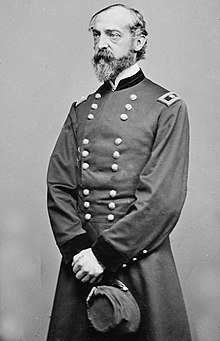George Meade | |
|---|---|
 A portrait of Meade by Mathew Brady | |
| Birth name | George Gordon Meade |
| Nickname(s) | "Old Snapping Turtle" |
| Born | December 31, 1815 Cádiz, Spain |
| Died | November 6, 1872 (aged 56) Philadelphia, Pennsylvania, U.S. |
| Buried | Laurel Hill Cemetery, Philadelphia |
| Allegiance | |
| Service | |
| Years of service | 1835–1836 1842–1872 |
| Rank | |
| Commands | United States Lake Survey I Corps V Corps Army of the Potomac Military Division of the Atlantic Department of the South Third Military District |
| Battles / wars |
|
George Gordon Meade (December 31, 1815 – November 6, 1872) was a United States Army Major General who commanded the Army of the Potomac during the American Civil War from 1863 to 1865. He fought in many of the key battles of the Eastern theater and defeated the Confederate Army of Northern Virginia led by General Robert E. Lee at the Battle of Gettysburg.
He was born in Cádiz, Spain, to a wealthy Philadelphia merchant family and graduated from the United States Military Academy in 1835. He fought in the Second Seminole War and the Mexican–American War. He served in the United States Army Corps of Topographical Engineers and directed construction of lighthouses in Florida and New Jersey from 1851 to 1856 and the United States Lake Survey from 1857 to 1861.
His Civil War service began as brigadier general with the Pennsylvania Reserves, building defenses around Washington D.C. He fought in the Peninsula Campaign and the Seven Days Battles. He was severely wounded at the Battle of Glendale and returned to lead his brigade at the Second Battle of Bull Run. As a division commander, he won the Battle of South Mountain and assumed temporary command of the I Corps at the Battle of Antietam. Meade's division broke through the lines at the Battle of Fredericksburg but were forced to retreat due to lack of support. Meade was promoted to major general and commander of the V Corps, which he led during the Battle of Chancellorsville.
He was appointed to command the Army of the Potomac just three days before the Battle of Gettysburg and arrived on the battlefield after the first day's action on July 1, 1863. He organized his forces on favorable ground to fight an effective defensive battle against Robert E. Lee's Army of Northern Virginia and repelled a series of massive assaults throughout the next two days. While elated about the victory, President Abraham Lincoln was critical of Meade due to his perception of an ineffective pursuit during the retreat, which allowed Lee and his army to escape back to Virginia. Meade's troops had a minor victory in the Bristoe Campaign but a stalemate at the Battle of Mine Run. Meade's cautious approach prompted Lincoln to look for a new commander of the Army of the Potomac.
In 1864–1865, Meade continued to command the Army of the Potomac through the Overland Campaign, the Richmond–Petersburg Campaign, and the Appomattox Campaign, but he was overshadowed by the direct supervision of the general-in-chief, Lt. Gen. Ulysses S. Grant, who accompanied him throughout these campaigns. Grant conducted most of the strategy during these campaigns, leaving Meade with significantly less influence than before. After the war, Meade commanded the Military Division of the Atlantic from 1865 to 1866 and again from 1869 to 1872. He oversaw the formation of the state governments and reentry into the United States for five southern states through his command of the Department of the South from 1866 to 1868 and the Third Military District in 1872. Meade was subjected to intense political rivalries within the Army, notably with Major Gen. Daniel Sickles, who tried to discredit Meade's role in the victory at Gettysburg. He had a notoriously short temper which earned him the nickname of "Old Snapping Turtle".